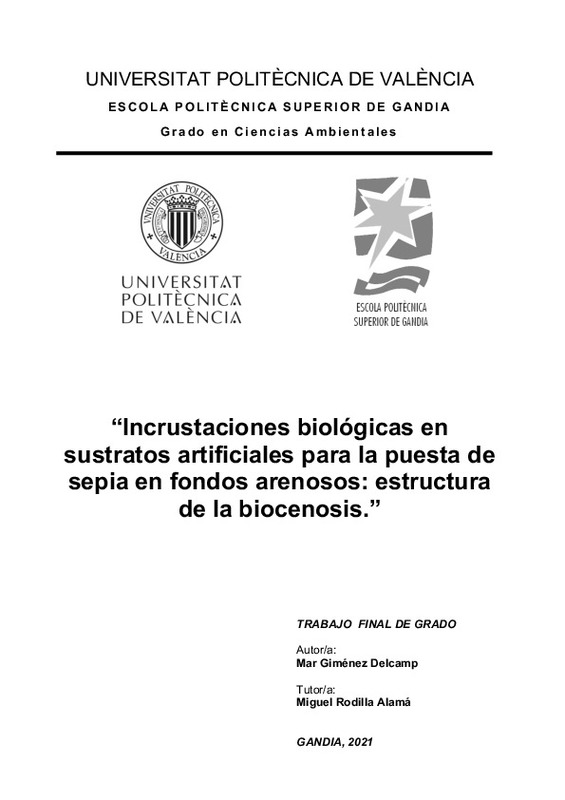|
Resumen:
|
[ES] Los cefalópodos son organismos de gran importancia pesquera, por lo que es importante sustentar estos organismos. Para ello la Cofradía de Pescadores de Gandía ha sumergido unas líneas para la puesta de huevos de Sepia ...[+]
[ES] Los cefalópodos son organismos de gran importancia pesquera, por lo que es importante sustentar estos organismos. Para ello la Cofradía de Pescadores de Gandía ha sumergido unas líneas para la puesta de huevos de Sepia officinalis frente la playa de Guardamar a las cuales han denominado sepieras. Estas se encuentran fondeadas en un área de 7500 m2 sobre un fondo arenoso, el cual predomina ampliamente sobre los sustratos duros en el medio marino. Debido a la escasez de este tipo de sustratos artificiales, estos son rápidamente colonizados por los organismos adaptados a vivir en fondos duros que deben competir fuertemente entre sí para obtener un espacio donde fijarse y prosperar. Este trabajo tiene como objetivo averiguar la composición y la estructura de los organismos que colonizan las estructuras artificiales, y analizar como avanza esta colonización en el tiempo estudiando dos sepieras fondeadas en distintos periodos de tiempo. Se han observado un total de 39 especies en las dos muestras obtenidas, con una gran diferencia entre las dos sepieras tanto en numero de especies, de individuos y de biomasa. Entre los organismos observados destacan los anfípodos de la especie Apocorophium acutum, el cual se ha encontrado en grandes cantidades y se considera la base alimenticia de muchos organismos, así como las ascidias e hidrozoos que son responsables de la complejidad estructural en el sustrato que permite albergar a muchas espcies.
[-]
[EN] Cephalopods are organisms of great fishing importance, so it is important to sustain these organisms. For this, the Gandía Fishermen's Association has submerged some lines for the laying of Sepia officinalis eggs in ...[+]
[EN] Cephalopods are organisms of great fishing importance, so it is important to sustain these organisms. For this, the Gandía Fishermen's Association has submerged some lines for the laying of Sepia officinalis eggs in front of the Guardamar beach, which they have called sepieras. These are anchored in an area of 7,500 m2 on a sandy bottom, which largely predominates over hard substrates in the marine environment. Due to the scarcity of this type of artificial substrates, they are quickly colonized by organisms adapted to live in hard bottoms that must compete strongly with each other to obtain a space to fix themselves and thrive. The objective of this work is to find out the composition and structure of the organisms that colonize artificial structures, and to analyze how this colonization progresses over time by studying two cuttlefish anchored in different periods of time. A total of 39 species have been observed in the two samples obtained, with a great difference between the two seperas both in number of species, individuals and biomass. Among the organisms observed, the amphipods of the species Apocorophium acutum stand out, which has been found in large quantities and is considered the food base of many organisms, as well as the sea squirts and hydrozoa that are responsible for the structural complexity in the substrate that allows them to host to many species.
[-]
|







